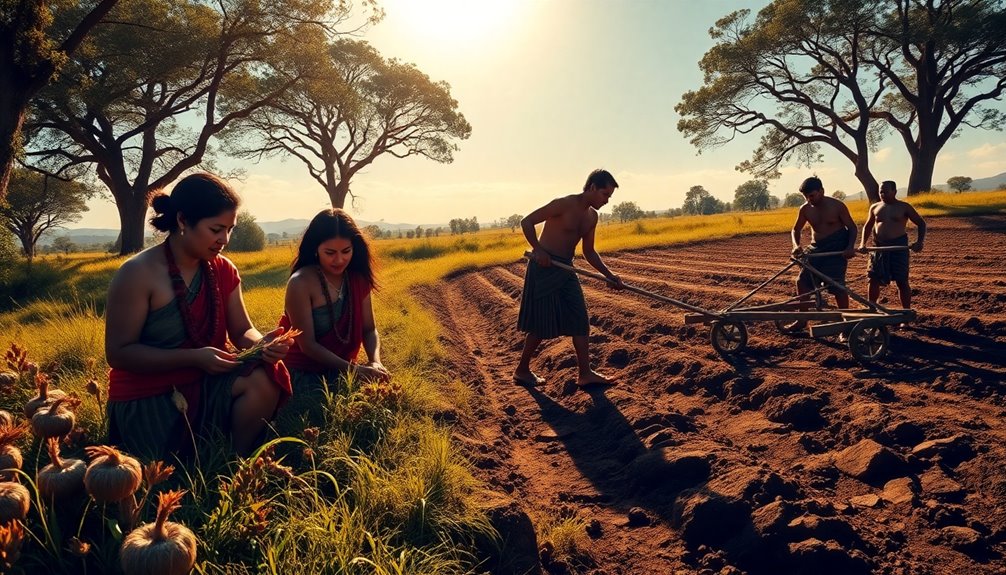Foraging societies, which thrived for about 200,000 years, began to fade about 10,000 to 12,000 years ago as the Neolithic Revolution took hold. This period marked the shift from hunting and gathering to settled farming, fundamentally changing human life. As agriculture emerged, populations grew, communities formed, and complex social structures developed. The domestication of plants and animals allowed for greater food production and led to trade and specialization. You'll discover how these changes influenced everything from social dynamics to cultural practices as humanity evolved toward agriculture and built the foundations of modern society.
Key Takeaways
- Foraging societies thrived for about 200,000 years, representing 95% of human history before the agricultural revolution began around 12,000 years ago.
- The Neolithic Revolution marked a significant shift from foraging to agriculture, with permanent settlements emerging approximately 10,000 to 12,000 years ago.
- Agricultural advancements increased food production, supporting larger populations and leading to the decline of traditional foraging practices.
- Regional variations in farming practices began around 9,000 years ago, contributing to the gradual disappearance of foraging societies in favor of settled agriculture.
- By the end of the Neolithic period, foraging had largely diminished, replaced by complex societies characterized by agricultural specialization and social stratification.
Defining Foraging Societies

Foraging societies, often referred to as hunter-gatherers, rely on hunting, gathering, and foraging for their sustenance. These societies, which thrived for about 200,000 years, represent roughly 95% of human history. Before the Neolithic Revolution, they utilized a diverse diet comprised mainly of wild edible plants, game, and other natural resources.
You'd find that foraging groups possessed an impressive understanding of their local ecosystems, identifying over 500 varieties of food each year and tracking seasonal changes in plant growth and animal breeding.
Social structures among foraging societies were typically egalitarian, with leadership roles emerging situationally rather than being fixed. Kinship acted as a crucial social bond within these small, mobile groups.
Contrary to popular belief, research shows that these societies enjoyed ample resources and expended less energy, working only 2-3 days a week. This lifestyle provided them with considerable leisure time, allowing for socialization and cultural development.
Historical Context of Agriculture

As you explore the historical context of agriculture, you'll see how the change to agricultural societies marked a pivotal shift from foraging lifestyles.
The Neolithic Revolution not only revolutionized food production but also led to population growth and the rise of villages.
You'll also notice how regional variations in farming practices emerged, reflecting local environments and cultures.
Transition to Agricultural Societies
Changing from nomadic lifestyles to settled farming practices marked one of humanity's most profound changes. This shift, known as the Neolithic Revolution, began about 10,000 to 12,000 years ago. It fundamentally altered how you and your ancestors interacted with the environment.
During this time, people shifted from foraging to agricultural methods, leading to the domestication of plants and animals. Sleep was often disrupted in agricultural societies due to increased responsibilities, influencing their overall health and wellness. The implementation of merchant services also emerged as communities began to trade surplus goods, enhancing economic relationships. Additionally, this period saw a rise in the use of non-perishable items as societies began to store food for future needs.
Key developments during this period include:
- Emergence of Permanent Settlements: As farming took hold, communities established fixed locations, paving the way for larger populations.
- Population Growth: With reliable food sources, birth rates increased, and societies expanded, leading to more complex social structures.
- Regional Innovations: Various regions, like the Fertile Crescent and Mesoamerica, independently cultivated crops, showcasing diverse agricultural practices.
While foraging societies began to decline around this time, some groups adapted and persisted, proving that flexibility in lifestyle can coexist with significant societal changes. Additionally, the rise of dairy cooperatives during agricultural advancements played a crucial role in shaping food production and availability.
The shift to agricultural societies not only transformed food production but also set the stage for the development of civilizations as you know them today.
Impact of Neolithic Revolution
The Neolithic Revolution had a profound impact on human societies, laying the groundwork for modern civilization. This pivotal period, occurring around 10,000 to 12,000 years ago, marked a significant shift from hunters and gatherers to settled agricultural practices.
As people began to domesticate plants and animals, they developed farming techniques that dramatically increased food production. This newfound abundance supported larger populations, enabling communities to thrive. In addition to this, the cultivation of crops often resulted in higher nutrient density compared to relying solely on whole fruits, which were previously a staple in foraging societies. Furthermore, the shift to agriculture created new opportunities for self-love and emotional alignment among communities as they formed deeper social bonds through shared labor and resources. This transition also reflects the importance of cultural intelligence in adapting to new social and economic structures as societies became more complex. Additionally, engaging in communal activities like farming can enhance social interactions, mirroring the collaborative spirit fostered through imaginative play with Waldorf toys.
Archaeological evidence, particularly from the Fertile Crescent, highlights early agricultural innovation, with the exploitation of wild grains dating back 14,500 years. As agriculture took root, it led to the emergence of private property and patriarchal structures, fundamentally altering social dynamics. The once-nomadic groups evolved into more complex societies, laying the groundwork for future civilizations. Additionally, the shift towards agriculture diminished the reliance on wild edibles, which were previously essential for sustenance.
Regional Variations in Farming
Farming practices evolved in diverse ways across different regions, shaped by local environments and resources. Early humans adapted their agricultural techniques based on the specific conditions they encountered.
For instance, you can see these regional variations in several key areas:
- Rice Cultivation: In China's Yellow River valley, rice farming began around 9,000 years ago, making it one of the earliest forms of agriculture.
- Maize Domestication: South America saw the domestication of maize between 7,000 to 9,000 years ago, which became a staple crop for many communities.
- Fertile Crescent: This area featured diverse grass species, including wheat and barley, promoting sedentary lifestyles due to stable yields. Furthermore, the reliance on sustainable practices is a concept that emerged as societies began to understand the importance of maintaining their agricultural environments. Additionally, the implementation of fire safety regulations helped protect farming communities from potential fire hazards caused by agricultural activities. Solar energy can also be harnessed to power irrigation systems, enhancing agricultural productivity in these regions. The introduction of organic farming practices has also gained popularity as societies increasingly prioritize sustainability in their agricultural methods.
The geographical conditions and local biodiversity led to specialized practices, such as slash-and-burn agriculture.
Additionally, the relationship between domesticated crops and animals marked a significant shift in these societies. As farming spread, you can see how interdependence developed, influencing food production systems and shaping cultures across various regions. This transition laid the groundwork for Required Minimum Distributions as communities began to accumulate wealth in agricultural assets.
Understanding these variations not only highlights humanity's adaptability but also showcases the rich tapestry of agricultural history.
Social Structures and Gender Roles

In foraging societies, social structures often reflect a remarkable egalitarianism, where leadership emerges based on individual skills rather than fixed positions. In hunter-gatherer communities, kinship and band membership are essential, fostering strong social bonds that support individuals within the group.
While traditional gender roles typically assign men the task of hunting large game and women the responsibility of gathering plants, research reveals a more nuanced reality. In fact, women participate in hunting in 79% of modern foraging societies, demonstrating that gender roles are more flexible than previously thought.
Matrilocal postmarital residence practices also highlight the significance of women's roles in family units, particularly in supporting young mothers. This structure not only reflects the vital roles women play but also indicates the community's understanding of shared responsibilities.
The division of labor in these societies is complex, having begun around 80,000 to 70,000 years ago, which emphasizes that social roles aren't strictly defined. Instead, they adapt and evolve based on environmental needs and individual skills, showcasing the rich tapestry of social structures and gender roles in our early human history. Additionally, the evolving roles in these societies often mirror the principles of key domains of development, illustrating how early human interactions shaped their growth and adaptation.
Economic Systems in Hunter-Gatherer Societies

Foraging societies thrive on a unique economic system that prioritizes mutual exchange and resource sharing. This gift economy fosters a strong sense of community, where members support each other and guarantee everyone's needs are met. The economic systems in these societies are generally egalitarian, with minimal wealth inequality, as indicated by an average Gini coefficient of 0.25.
Key features of hunter-gatherer economies include:
- Sustainable Resource Management: Hunter-gatherers utilize over 500 varieties of food annually, demonstrating extensive knowledge of local flora and fauna while minimizing waste.
- Work-Life Balance: Typically, they work around 6.5 hours per day, allowing for more leisure time compared to the 8.8 hours of agricultural workers, although some argue this may not account for food preparation.
- Situational Leadership: Leadership is often situational, based on expertise rather than hierarchy, promoting an egalitarian atmosphere where everyone contributes.
Through resource sharing and communal support, hunter-gatherer societies create an economic foundation that not only sustains them but also reinforces social bonds, setting a stark contrast to more rigid, hierarchical systems that emerged with farming.
Evolutionary Perspectives on Farming

The shift from foraging to agriculture represents a pivotal moment in human history, reshaping societies and their interactions with the environment. This change began around 12,000 years ago but was rooted in gradual alterations that may date back as far as 19,000 years ago.
You see, the agricultural revolution didn't happen overnight; instead, it involved a complex interplay of climate change and resource availability that encouraged early humans to combine foraging lifestyles with initial farming efforts.
As you explore archaeological excavations, you'll uncover evidence of diverse adaptations to local environments, particularly in regions like the Fertile Crescent and China's Yellow River valley. These areas independently developed agriculture, showcasing how different societies responded to their unique circumstances.
The domestication of plants and animals marked a significant turning point, drastically increasing food production and leading to population growth. This newfound stability allowed for the establishment of permanent settlements, fundamentally altering social structures and interactions.
Archaeological Insights and Discoveries

As you explore key archaeological sites, you'll uncover evidence that reshapes our understanding of early agriculture.
Discoveries in places like the Azraq Basin reveal complex social structures among hunter-gatherers, suggesting they weren't just transient groups.
These findings hint at a gradual evolution from foraging to farming, highlighting the intricate relationship humans had with their environment.
Key Archaeological Sites
Key archaeological sites across regions like the Azraq Basin in Jordan and the Fertile Crescent reveal fascinating insights into the lives of ancient hunter-gatherers and early farmers. These discoveries challenge previous assumptions about their lifestyles and provide a deeper understanding of human history.
- The Kharaneh IV site, spanning nearly two hectares, was occupied for 1,200 years, showcasing a significant congregation of hunter-gatherers. Here, you'll find stone tools, animal bones, and oval hut structures that indicate complex social structures, reflecting the importance of socialization in developing community bonds. This complexity may also parallel the need for advance directives in modern societies, emphasizing the importance of planning for future uncertainties. Furthermore, this site exemplifies the concept of community building, which is essential for the growth of cohesive societies. Additionally, these early social structures may have laid the groundwork for investment strategies that promote resource allocation in later agricultural societies.
- Excavations in the Azraq Basin have uncovered over 1,400 skeletons, revealing sophisticated burial practices among hunter-gatherers. This suggests emotional ties and intricate social relationships within these communities.
- Research in the Fertile Crescent highlights its critical role in early agricultural innovation. Archaeological sites here provide evidence of the gradual shift from foraging to farming, marking pivotal moments in human history. Additionally, studies indicate that air quality significantly impacts health, particularly for vulnerable populations.
Together, these key archaeological sites illustrate the evolution of societies, shedding light on the behavioral complexity and cultural practices of early humans.
Evidence of Early Agriculture
Evidence from various archaeological sites shows that early agriculture began to emerge around 12,000 years ago, marking a significant change from foraging to farming. This alteration wasn't instantaneous; evidence suggests it evolved over millennia, with significant developments occurring as far back as 19,000 years ago. In places like the Fertile Crescent, discoveries of tools, seeds, and rock art point to early agricultural practices taking shape.
Excavations, such as those at the Kharaneh IV site in Jordan, reveal that hunter-gatherers congregated for extended periods, fostering the social complexity necessary for agriculture. Additionally, the analysis of over 1,400 skeletons indicates cultural complexities among these groups that may have influenced their shift toward farming. Controlled fires and techniques like slash-and-burn agriculture demonstrate early humans' adaptability and experimentation with land management.
| Region | Evidence Type | Age (Years Ago) |
|---|---|---|
| Fertile Crescent | Tools and seeds | 12,000 |
| Kharaneh IV, Jordan | Social complexity | 12,000 |
| Various sites | Burial practices | 19,000 |
Modern Foraging Practices

Modern foraging practices thrive in various communities, blending traditional hunting and gathering methods with today's challenges. By adapting to contemporary environments, you can gain valuable insights into sustainable food practices.
Many contemporary foragers possess extensive knowledge of local ecosystems, identifying over 500 varieties of edible plants and understanding seasonal cycles that promote sustainable harvesting.
Here are three key aspects of modern foraging practices:
- Resource Management: Modern foragers emphasize minimizing waste and maximizing the use of local resources, creating a sustainable relationship with nature.
- Urban Foraging: As cities grow, individuals are increasingly seeking out wild edible plants, reflecting a rising interest in local food sources and sustainable living.
- Cultural Preservation: Groups like the Pila Nguru and the Sentinelese maintain traditional ways of life, showcasing resilience against agricultural influences while preserving their cultural heritage.
The Impact of Agriculture on Society

As foraging practices adapted to contemporary life, the rise of agriculture fundamentally transformed human society. This shift, occurring around 10,000 to 12,000 years ago, brought significant population growth and led to the establishment of permanent settlements. The development of modern heating solutions has also shown how technological advancements can enhance living conditions in these settlements. Additionally, the emergence of heat pumps has contributed to increased energy efficiency, further improving the comfort of these growing communities.
With agriculture as the primary means of sustenance, communities could support larger populations, reshaping societal structures in profound ways. Agricultural advancements, including the development of metal tools, improved farming techniques, and boosted food production. This surplus of grain enabled specialization and division of labor, giving rise to more complex societal roles and various professions.
As people settled and formed communities, concepts of private property emerged, along with patriarchal structures that influenced power dynamics within these groups. Additionally, agriculture laid the groundwork for river-valley civilizations, which blossomed in regions rich with agricultural resources. These innovations provided the necessary framework for the growth of urban centers and complex societies.
Moreover, the integration of energy-efficient technologies in agricultural practices has further enhanced productivity and sustainability in farming.
Frequently Asked Questions
When Did Humans Stop Being Foragers?
Humans didn't stop being foragers overnight; it was a gradual process. Around 10,000 years ago, as agriculture emerged, many communities began to shift their subsistence strategies.
While some continued foraging well into modern times, cultural changes and urbanization pushed others toward farming.
You'll find that even today, some contemporary hunter-gatherers exist, showcasing how adaptable and resilient humans can be in the face of changing environments and societal pressures.
Why Did Humans Shift From Foraging to Farming?
Isn't it ironic that humans, who once thrived on the spontaneity of foraging, eventually chose to cultivate crops?
You shifted to farming mainly for stability and reliable food sources. As climates changed, you recognized the need to adapt.
The domestication of plants and animals allowed your communities to grow, settle, and develop complex societies.
This new lifestyle offered not just food security, but also a chance to build lasting relationships and property ownership.
When Did Foraging End?
Foraging didn't end abruptly; it gradually diminished over thousands of years.
Around 10,000 years ago, as agriculture began to take hold, many communities shifted to farming practices.
However, some groups continued foraging well into modern times, adapting their lifestyles.
You'll find that this change varied by region, with some areas embracing agricultural methods faster than others, allowing remnants of foraging societies to persist despite the growing dominance of agriculture.
When Did Hunter-Gatherer Societies End?
You can't teach an old dog new tricks, but hunter-gatherer societies have shown remarkable adaptability throughout history.
These groups began to fade around 10,000 years ago as agriculture took root, leading to settled lifestyles.
While many shifted to farming, some communities held onto their foraging practices.
Today, a few groups still thrive, showcasing that despite the odds, the spirit of hunter-gatherer living endures, even as the world around them changes.
Conclusion
To summarize, the shift from foraging to farming transformed human societies in ways we're still unpacking today. Did you know that around 10,000 years ago, nearly 90% of humanity lived as foragers? This drastic change not only altered our diets but also reshaped social structures and economies. While foraging has largely faded, some modern practices still echo these ancient ways, reminding us of our resilient connection to the land and each other.










